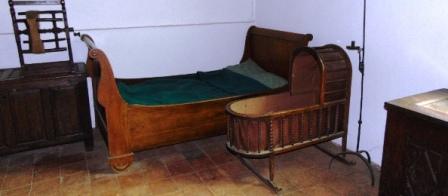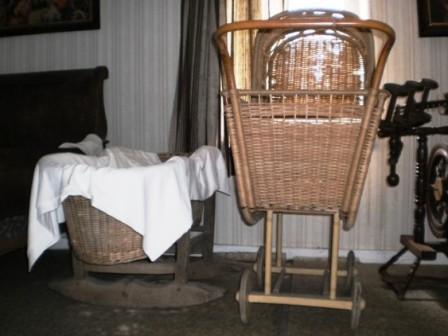To sleep or rest we seek a snug, comfortable nest. Especially in Latin America is often slept in a hammock. Christopher Columbus brought the hammock to Europe. Because it occupies little space by their suspension and they absorb the movement of the ship (partly) they are still used on (sailing) ships. A cloth or net just tied between two points is enough to lounge and rock.
 The original form is without poles. You lie diagonally in them. In the biggest it may even cross.
The original form is without poles. You lie diagonally in them. In the biggest it may even cross.
With sticks holding the rag open it seems easier, but they are more volatile and less comfortable.
To make a sleeping surface smoother our ancestors used what they could find in their environment. Dry material in a dry place, otherwise it molds and rots:
moss, leaves, grasses and herbs, skins.
To keep the material together it was placed in a bed box or in a bedstead, only later in bags or mattresses sewn from cotton (tick) (or jute). Mattress can be traced back to the Arabic al Maţraḩ 'the seat cushion' (Italian: materasso).
Most used was the straw mattress. Still in 1958 brand new conscripts in the barracks got as first task to fill their straw bag with straw. Straw mattresses must be very often and well aired. The dressing was renewed 1 to 4 times per year. The old straw came through the stable and the compost back into the ecological cycle.
Sometimes sweet woodruff (Galium odorata) was mixed to smell better.
Also gale, mint and coriander were used to keep pests away.
Yellow- and lady’s bedstraw (Galium verum) was used as an air freshener and refill that even killed fleas.
Also, the roots of the royal fern (Osmunda regalis) were dried and the sheet was used as a louse -resistant mattress filling.
 Dried eel grass (Zostera) is strong, don’t rot and insulates well. It is sturdy, resilient and has a fine texture. Except as mattress and seat padding it was for centuries a great roofing and gap closer. It was also used as a coating for strong seawalls. Dykes were also made of seagrass. On the old south coast of Wieringen (Nl) is one that served for more than100 years.
Dried eel grass (Zostera) is strong, don’t rot and insulates well. It is sturdy, resilient and has a fine texture. Except as mattress and seat padding it was for centuries a great roofing and gap closer. It was also used as a coating for strong seawalls. Dykes were also made of seagrass. On the old south coast of Wieringen (Nl) is one that served for more than100 years.
The long, white lint from the seed of cotton grass (Eriophorum angustifolium) served as a soft pillow and mattress stuffing, as well as broadleaf cattail (Typha latifolia) fluff.
Heather was also (perhaps for lack of a better alternative) used.
(Later, a lot of kapok, the soft fibers from the fruits of a ceiba tree (Ceiba pentandra), were imported for this.)
Animal materials
A mattress stuffed with goose or duck feathers was also called a ”shake bed” here, because it had to be often (sometimes daily) fluffed to keep the material evenly distributed and soft. This also applies for wool (which could otherwise become felt).
Horsehair is a durable material that is still used as a cover layer nowadays. Horsehair would be even more resilient as it gots a curl treatment by steaming at temperatures above 100 degrees.
The mattress was usually placed on a mesh of branches, ropes or thongs, or slatted frame with shelves.
A bolster (Latin: pulvinus) is a head mattress or large pillow. A pillow (Latin: coxinus) was a bag with soft padding to support parts of the body (or in some works as a shock absorber).
Today there are still sold pillows filled with buckwheat hulls.
(Also with cherry pits, you can heat them comfortably in the oven.
You can de-stain cherries on a bottle with an opening where the cherry cannot pass through, but the kernel does. Prick the kernel with a chopstick, straw or tube. (Paperclip handsome…))
Canopy beds were at that time not as romantic as they seem meant now. The canopy (“heaven") offered protection against mice and debris that could otherwise fall out of the thatched roof and in the bed.
Around 1500, most houses had straw roofs. In heavy rain, sometimes sheltering cats (and dogs) could fall out. Hence ‘it’s raining cats and dogs’. Other earthlings also took refuge there. Insects, mice, ... Some fell, and others dropped something. That was especially unfortunate for the bedding. To avoid decorations, 4 posts were placed around the bed with a protective sheet over it. This is how the romantic "four-poster bed" was created.
Curtains around could repel flying insects, gave extra insulation and privacy.
(Also dignity characters as altars, pulpits, fonts, thrones etc. often acquired a stately canopy.)
Apparently I toss and turn a lot in bed. And have little sense to spend much time formatting the bed. The solution: a pair of elastic suspenders with clips to connect andkeep under the mattress the fitted sheet neatly in place.
Take responsibility for yourself because no one is going to do that.
